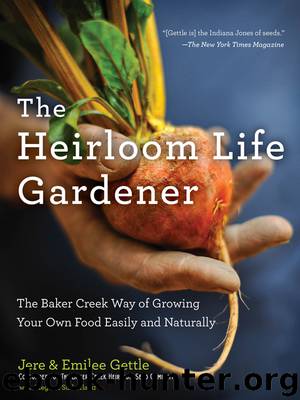The Heirloom Life Gardener by Jere Gettle

Author:Jere Gettle
Language: eng
Format: mobi
Publisher: Hyperion
Published: 2011-10-22T21:00:00+00:00
Corn
Zea mays
Corn is a truly American vegetable that originated in Mexico and was developed into a staple crop over the course of thousands of years from a wild grass called teosinte. It is one of the main botanical backbones of many cultures around the globe, for its taste, nutrition, and how easy it is to grow.
As a child, I loved peeling back the husks and seeing what was inside an ear of corn—it was like flipping open a crayon box and encountering that rainbow of possibilities. One of my favorites is Hopi Blue, a very dark, midnight-blue native strain that you can whip up into a tasty cornbread. Strawberry Popcorn has ears that look like giant red strawberries. I also treasure the multicolored ears of the Rainbow Indian corn for their sheer beauty, though I don’t cook with it too often. As one part of the “three sisters” of Native American agriculture (along with squash and beans), corn was traded widely throughout North and South America long before the time of the explorers, and it was loved by Europeans, who quickly realized that it gives much higher yields than other grains, in a variety of climate conditions.
Corn comes in a spectacular array of colors, from blue-violet, blood-red, yellow, pink, and orange, to ivory, periwinkle blues, rich chocolate-brown, and even shades of green. And many different types have been used in different ways over the years. Sweet corn—so-named because its kernels are loaded with sugar—is the most popular kind of corn for eating in America. When corn is eaten on the cob, for example, it’s usually sweet corn. Our favorites are Black Aztec and Golden Bantam. Dent and flour corn varieties, like Thompson Prolific and Pencil Cob, have soft kernels that are easy to grind up, so they’re commonly used for flour and feed. Flint corn is the granddaddy of all corns. Varieties like Wade’s Giant and Rainbow Indian are hard, shiny, and gorgeously glassy. Popcorn is also a type of flint corn.
As agriculture developed in the United States, corn quickly became king. And it’s become the most popular grain crop produced in America. Sadly, along with this mass production, many traditional varieties have been lost. Older corns with a higher protein and mineral content fell out of favor because they had smaller yields and because they weren’t as uniform.
This is a major problem, because the prevalence of genetically modified corn is leading to the demise of diversity. Most corn that is grown in America can now survive being sprayed with huge amounts of Roundup, Monsanto’s chemical weed controller.
The big agribusiness companies have also created corn that actually produces its own toxic insecticide, so that if a corn borer eats it, it will get sick within a matter of hours and die off. This may be good for higher yields for the big growers, but there are many unknowns about the safety of such engineering. It is believed that GM corn leads to health problems in lab animals, such as lesions, birth defects, and cancer.
Download
This site does not store any files on its server. We only index and link to content provided by other sites. Please contact the content providers to delete copyright contents if any and email us, we'll remove relevant links or contents immediately.
Turbulence by E. J. Noyes(7936)
The Thirst by Nesbo Jo(6828)
Gerald's Game by Stephen King(4583)
Be in a Treehouse by Pete Nelson(3948)
Marijuana Grower's Handbook by Ed Rosenthal(3623)
The Sprouting Book by Ann Wigmore(3543)
The Red Files by Lee Winter(3368)
The Remains of the Day by Kazuo Ishiguro(3293)
Sharp Objects: A Novel by Gillian Flynn(2956)
Christian (The Protectors Book 1) by L. Ann Marie(2654)
Organic Mushroom Farming and Mycoremediation by Tradd Cotter(2626)
The Culinary Herbal by Susan Belsinger(2431)
Stone Building by Kevin Gardner(2350)
The Starter Garden Handbook by Alice Mary Alvrez(2282)
Lilac Girls by Martha Hall Kelly(2258)
The Unlikely Pilgrimage of Harold Fry by Rachel Joyce(2220)
The Lean Farm Guide to Growing Vegetables: More In-Depth Lean Techniques for Efficient Organic Production by Ben Hartman(2096)
Urban Farming by Thomas Fox(2061)
Backyard Woodland by Josh VanBrakle(1895)
